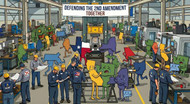How We Manufacture Your 80 Lower Receiver
Posted by Tactical Machining Engineering Team on Nov 23rd 2025
From Billet to Box: How We Manufacture Your 80 Lower Receiver
We are an OEM (Original Equipment Manufacturer) based in the USA. We don't just stock parts; we engineer them. Explore our process below to see exactly what goes into your build.
Interactive Guide: What We Do vs. What You Do
Click the red markers to see the manufacturing details.

Click a red marker on the receiver to learn about the machining process.
Step 1: Choose Your Metal
Not all aluminum is created equal. Use the tool below to compare our two aircraft-grade alloys.
7075-T6 Forged Aluminum
The gold standard for military duty. Maximum rigidity and resistance to wear.
6061-T6 Billet Aluminum
The preferred choice for custom builds. Superior corrosion resistance and easier to mill at home.
Step 3: The "80%" Stop (Compliance)
To ensure your privacy, we machine the receiver almost to completion. We intentionally leave the fire control pocket solid and the safety selector holes undrilled. Because these final steps are left to you, the item is not considered a firearm and ships directly to your door.
* Policy Note: We are not attorneys, and laws vary throughout the country. Please check your local, state, and federal laws to ensure compliance before ordering.
Ready to Start Your Build?
Get the same receivers used by major OEMs, direct from the source.
Shop American-Made 80 LowersFrequently Asked Questions
Absolutely. 6061-T6 is an aircraft-grade alloy used in structural components for wings and fuselages. It is more than capable of handling the stress of an AR-15 or AR-10 receiver.
Yes. We are a true OEM based in the USA. We do not drop-ship receivers from other companies; we machine them ourselves on our own HAAS CNC mills.
No. Because the fire control pocket is not milled out, the ATF classifies this item as a "receiver blank," not a firearm. It ships directly to your home. (Note: Check your local and state laws as restrictions may apply).
"T6" refers to the heat treatment temper. It means the aluminum has been solution heat-treated and then artificially aged. This process significantly increases the yield and tensile strength of the metal compared to untreated aluminum.
Technically, yes. 7075 aluminum is slightly denser (2.81 g/cm³) than 6061 (2.70 g/cm³) due to its zinc content. However, for a standard AR-15 lower receiver, the weight difference is less than half an ounce—negligible for most builds.
Both accept paint and Cerakote well, but 6061 often provides a slightly more consistent surface finish for anodizing. For home painting, starting with a "Raw" (tumbled) lower of either alloy is ideal as it saves you the step of blasting off old finish.
6061-T6 is highly weldable. 7075-T6 is generally considered unweldable because it is prone to cracking under heat stress. If you plan on modifying your lower with welds, choose 6061.
7075 is chosen for its incredible strength-to-weight ratio. It offers strength comparable to some steels but at a fraction of the weight, making it ideal for aircraft gears, shafts, and structural spars.
All aluminum can oxidize, but 6061 actually has better corrosion resistance than 7075 because it contains less copper. If you are building a rifle for humid or marine environments, 6061 is an excellent choice.
While 7075 is harder (150 HB vs 95 HB), 6061 is still plenty strong for thousands of rounds. Unless you are running a full-auto sear with constant rotation, "pin hole wear" (egging) is extremely rare in semi-auto 6061 builds.
In terms of raw tensile strength, yes, Forged 7075 is stronger. However, Billet 6061 allows for thicker reinforced walls and integrated trigger guards that can add structural rigidity where forgings are thin. Both exceed the force required for standard firearm operation.
6061 is used in boat hulls, truck frames, and bicycle frames due to its weldability and corrosion resistance. 7075 is used in rock climbing carabiners, hang gliders, and missile parts where ultimate strength is critical.
Yes, but go slow. 7075 is harder and can grab drill bits if you push too hard. 6061 cuts like butter by comparison. If you are a first-time builder using a drill press, 6061 might be the more forgiving starting point.

